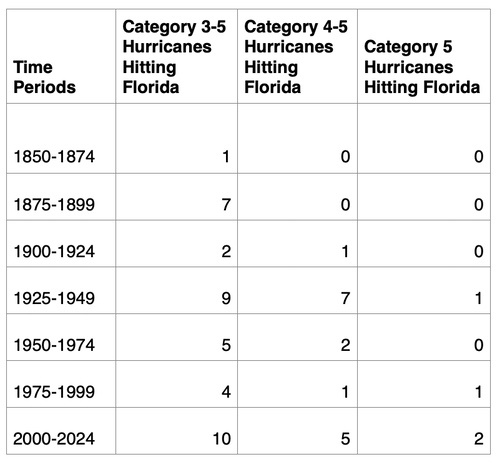Hurricanes are a force of nature. Yet the recent frequency of these destructive storms from the Atlantic and Caribbean doesn’t seem natural.
Evidence shows that they’re not only striking America in general, and Florida in particular frequency, but they’re also getting more destructive. This will hurt in terms of casualties, billions in damages, and insurance rates that could affect all home and car owners, not just those along the coast.
As I write this, Hurricane Helene is passing over where I live in Georgia, canceling college classes and events, and leading to catastrophic flooding in Atlanta, a city not used to hurricanes, after pummeling the Florida Panhandle. The Carolinas are getting flooded.
In years past, I looked at the increase of hurricane activity from the Atlantic, noting that there’s an increase storm frequency and destruction that occurred in the early 1900s, waning from the 1950s through the 1990s, followed by a rapid increase of these hurricanes this century. When critics claimed this was cyclical, and didn’t apply to the Pacific, I ran those numbers and found these deadly catastrophes occurring in both oceans.
Less than a decade later, these storms are not abating. In fact, if you only look at Florida, you can see the problem pretty clearly. I looked at all Category 3, 4, and 5 storms in 25-year increments. From 1850-1874, there was only one such storm. From 1875-1899, there were seven. Those fell to two between 1900-1924, but we saw our first Category 4 in the system.

From 1925-1949, there were nine such storms, with seven Cat 4-5 storms, and the first Category 5 storm, the killer Key West Hurricane from Labor Day, 1935. But thankfully such storms fell in number and ferocity. We had nine total storms over the next 50 years (five from 1950-1974 and four from 1975-1999), with only three reaching Category 4 level, and one of those (Andrew) being a Category 5.
In 2000-2024, the deadly hurricanes returned with a vengeance. We saw 10 severe storms, five of those being Category 4 level, and two of those (Michael and Ian) reaching Category 5 destruction levels. Michael passed over us in Georgia while our chaplain and I took students to help with the cleanup in Ft. Myers several months afterwards. Some still didn’t have power on Pine Island, and there was still enough destruction to look like a bomb went off.
Hurricane Helene made the top ten in terms of most intense tropical hurricanes to hit Florida, in terms of Barometric Pressure levels as well as wind speed, joining Michael, Ian and Irma, all just in the last seven years alone. Such data comes from HURDAT and HRD.
Hurricanes are forces of nature, but humans may play a role. In my research for The Observer, I hypothesized that we played a role, not just in possibly accelerating these, but also for reducing their frequency and intensity. In the 1950s and 1960s, a more environmentally conscious America moved to create agencies like the EPA and craft environmental legislation to curb abuses of God’s natural creation. Hurricanes didn’t completely disappear, but we had fewer cases, and less dangerous ones. The U.S. showed we could make meaningful changes.
But attempts to water down the EPA and environmental laws, coupled with countries in the developing world pushing greater levels of pollution-based industrialization, these terrible storms have returned to America in general, and Florida with a vengeance. It’s even led to an insurance crisis where there’s no guarantee our markets can cover our businesses and homes, or keep the costs from being passed on to all customers.
500 Year Storms seem to be happening all of the time. Politicians can put all the pressure they want on insurance companies, but if they go bankrupt, what then? Can our governments afford to pick up the tab? Will we build homes and invest in businesses if they aren’t protected?
With two more storms heading our way, how long do we have?
